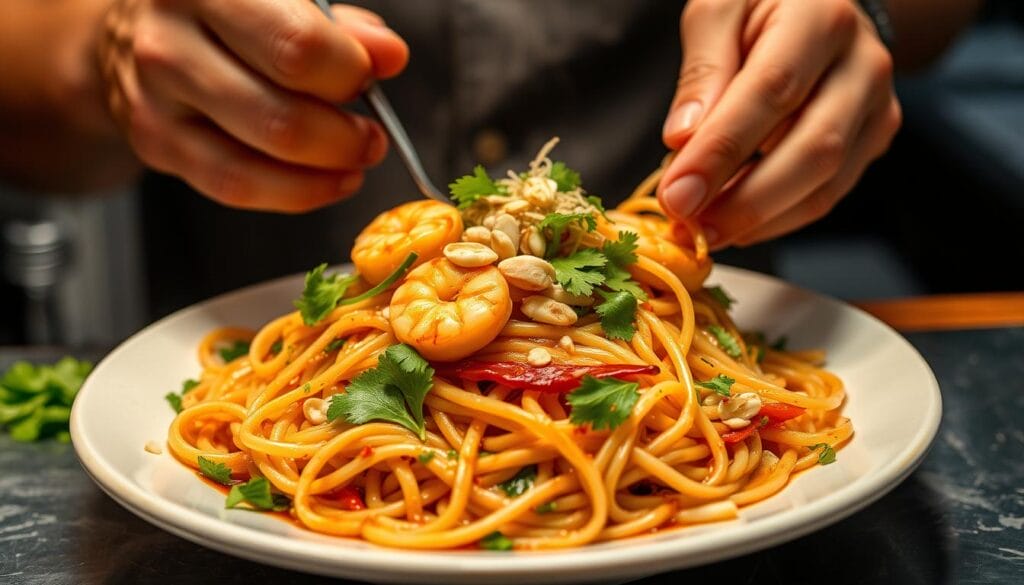I’m excited to share my love for Pad Thai, a traditional Thai noodle dish. It’s loved worldwide. This dish is made with stir-fried rice noodles, eggs, and ingredients like shrimp, chicken, or tofu. It’s flavored with tamarind, fish sauce, and palm sugar. For more on mastering flavor, visit pad thai recipe.
Pad Thai is a comfort food with chewy noodles, crunchy peanuts, and a sweet, tangy sauce. It’s filled with chives, bean sprouts, and chicken. Its rich history and cultural significance make it a staple in Thai cuisine, loved globally.
Introduction to Pad Thai
In this article, I’ll guide you through making Pad Thai at home. I’ll use a simplified recipe that keeps the authentic flavors. Whether you love traditional Thai cuisine or want to try something new, this recipe will impress your taste buds.
Key Takeaways
- Pad Thai is a traditional Thai noodle dish made with stir-fried rice noodles and various ingredients.
- The dish is flavored with tamarind, fish sauce, and palm sugar, giving it a sweet and savory taste.
- Pad Thai is a comfort food that consists of chewy noodles, crunchy peanuts, and plenty of chives and bean sprouts.
- The recipe yields 4 servings and can be made in under 50 minutes.
- Each serving contains 579 calories, 23 grams of fat, and 28 grams of protein.
- Pad Thai is a popular dish that has spread globally, and its recipe can be found in many cookbooks and online resources.
What is Pad Thai?
Pad Thai is a traditional Thai noodle dish loved by many. It’s a stir-fry with rice noodles, shrimp, tofu, and more. It’s served hot and has a long history.
Introduced in the 1930s by Chinese traders, Pad Thai has changed over time. Now, different parts of Thailand have their own twist on this dish.
According to hot-thai-kitchen.com, Pad Thai is a favorite in Thailand. It’s found at street stalls and restaurants. The mix includes rice noodles, eggs, tofu, and more.
Here are some key ingredients and nutritional information for Pad Thai:
- 4 ounces of dried rice stick noodles
- 6 ounces of boneless skinless chicken thigh
- 5 garlic cloves
- 2 eggs
- 2 tablespoons of tamarind paste/puree
- 2 tablespoons of fish sauce
- 2 tablespoons of brown sugar
- 2.5 teaspoons of oyster sauce
- Calories per serving: 278 kcal
- Carbohydrates per serving: 43g
- Protein per serving: 15g
- Fat per serving: 5g
The History of Pad Thai
Exploring Pad Thai’s history is truly captivating. This dish, known for its sweet and savory taste, has become a staple in Thai cuisine. It was first introduced in the 1930s as part of a campaign to unite Thailand.
The use of stir-fry rice noodles, brought by Chinese traders in the 1700s, was key to Pad Thai’s creation. Initially, it was promoted to help with a rice shortage caused by flooding and war. Street vendors soon made it widely available, making it Thailand’s first fast food.
Today, Pad Thai is celebrated as Thailand’s national dish. In 2011, it was voted the 5th most delicious food in the world by CNN Go. The Thai government has also launched efforts to promote Thai cuisine globally, aiming to boost exports and tourism.
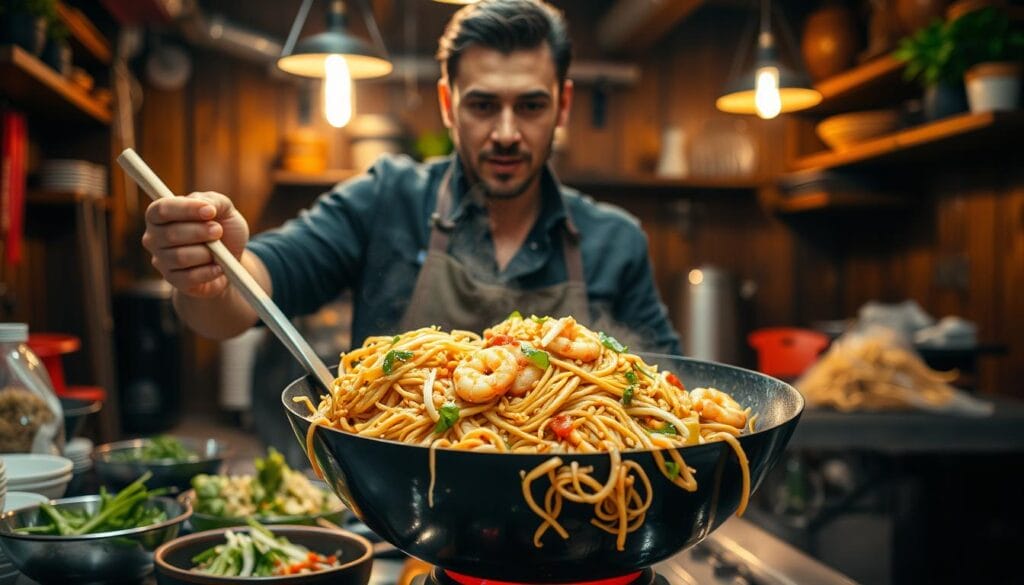
The strategy to promote Thai food has helped connect people to Thailand. This has led to more tourism and appreciation for Thai culture. Pad Thai’s rich history and delicious taste have made it a favorite worldwide, with its popularity growing every day.
Some key facts about Pad Thai include:
- It was created in the 1930s as part of a national identity campaign
- Stir-fry rice noodles were introduced to Thailand by Chinese traders in the 1700s
- Pad Thai was promoted as a way to address rice shortages during World War II
- It is now considered Thailand’s national dish and has gained global popularity
My Favorite Pad Thai Recipe
I’m excited to share my favorite pad thai recipe with you. This recipe combines authentic Thai flavors with easy-to-find ingredients. It’s perfect for a quick, tasty meal at home.
To begin, you’ll need basic items like rice stick noodles, fish sauce, and soy sauce. Choose your protein, like shrimp. The sauce blends fish sauce, soy sauce, brown sugar, rice vinegar, and sriracha. It’s sweet, sour, and savory.
For extra texture and taste, add crushed peanuts and bean sprouts.
Here’s what you’ll need:
- 8 oz rice noodles
- 2 tablespoons vegetable oil
- 1 lb medium shrimp, peeled and deveined
- 3 large eggs
- 3 tablespoons palm sugar
- 3 tablespoons fish sauce
- 2 tablespoons tamarind puree
- 1 tablespoon fresh lime juice
- 1/4 teaspoon cayenne pepper
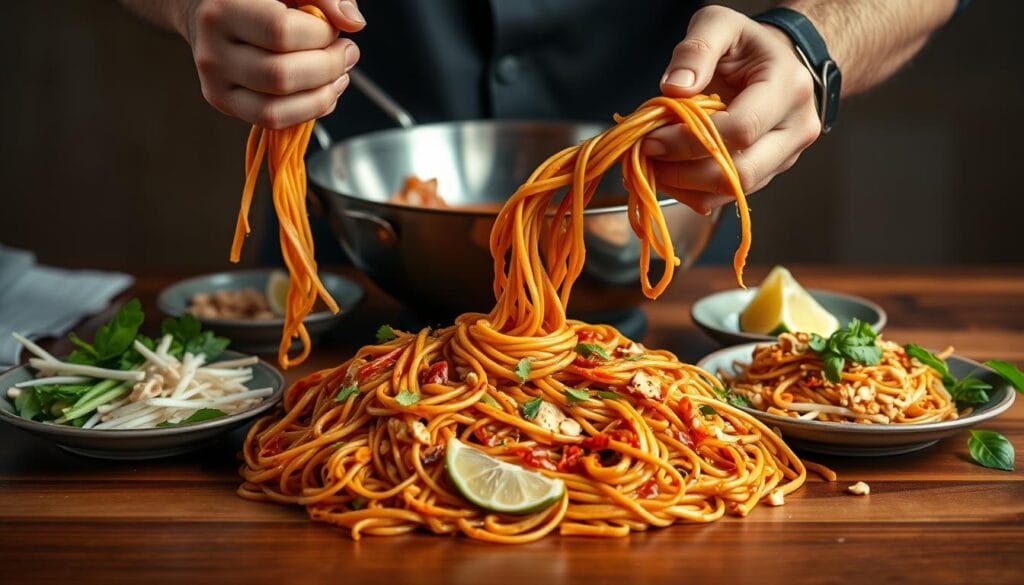
This recipe serves 3 people and takes under 30 minutes to make. It cooks in about 15 minutes. Each serving has 639 calories, 73g carbs, and 24g protein. You can also add your favorite ingredients or use different proteins.
How to Customize Your Pad Thai
To make your Pad Thai special, add your own twist. Try adding fried tofu and pickled radishes for a unique taste. You can also adjust the spiciness by adding more chili flakes or using different proteins.
For a unique flavor, add sweet and savory elements like palm sugar and fish sauce. Experiment with different noodles, such as rice or glass noodles, for a different texture. For a vegetarian or vegan version, use tofu or tempeh and add extra veggies like bean sprouts and garlic chives.
Here are some tips for customizing your Pad Thai:
- Add fried tofu or tempeh for a protein boost
- Incorporate pickled radishes or other vegetables for extra flavor
- Use different types of protein, such as chicken or shrimp, for a change of pace
- Experiment with sweet and savory elements, such as palm sugar and fish sauce, to create a unique flavor profile
- Try using different types of noodles, such as rice noodles or glass noodles, to change the texture of the dish
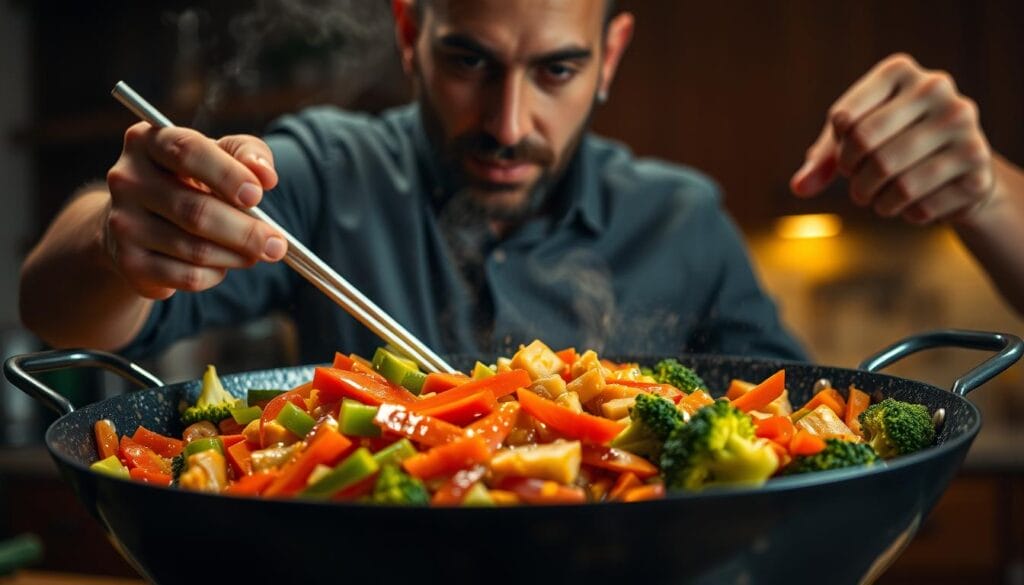
Follow these tips to create a Pad Thai that’s just right for you. Whether you prefer it sweet and savory or spicy and sour, the key is to experiment. So don’t be afraid to try new things – with practice, you’ll make delicious Pad Thai like a pro!
Essential Cooking Tips for Perfect Pad Thai
To make the perfect traditional Thai noodle dish, follow some key cooking tips. Start with high-quality ingredients like fresh veggies and spices. Soak the noodles in hot water until they’re half-soft before stir-fry.
Getting the noodle to sauce ratio right is also key. Too much noodle and not enough sauce makes them taste bland. Too much sauce and not enough noodles makes it too saucy. Cooking in a big pan helps prevent noodles from sticking together.
Here are some important tips to remember:
- Soak rice noodles in hot tap water until they are 50% softened before stir-frying
- Use a balanced noodle to sauce ratio
- Cook in a larger pan to reduce agitation and prevent sticky noodles
For a tasty and authentic traditional Thai noodle dish, check out easykitchen.me. They have great recipes and cooking tips. With these tips and a bit of practice, you’ll make perfect stir-fry Pad Thai.
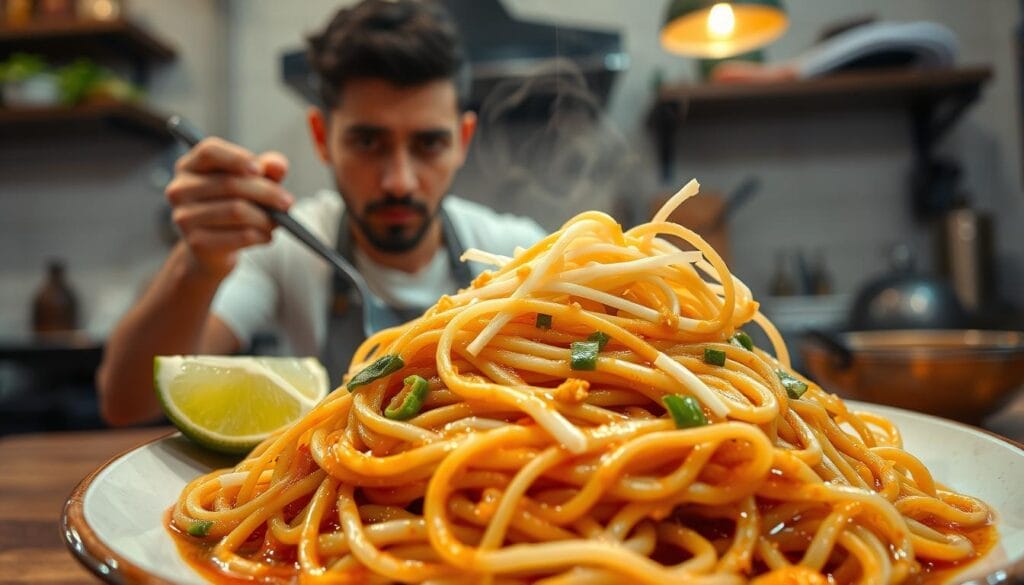
By using these tips and quality ingredients, you’ll make a delicious traditional Thai noodle dish. Always choose fresh ingredients and cook with love. This way, you’ll make Pad Thai that will wow your family and friends.
The Importance of Fresh Ingredients
For authentic Pad Thai, fresh ingredients are key. The dish combines sweet and savory tastes. High-quality ingredients are needed for this.
Fresh bean sprouts and chives are vital for real Pad Thai, sources say. A stir-fry is the best cooking method. It cooks ingredients fast and evenly.
To stir-fry well, use fresh, tasty ingredients. Tamarind pulp and fish sauce are must-haves. Here’s how to pick the best ingredients:
- Choose fresh, firm veggies like bean sprouts and carrots.
- Go for top-notch proteins like shrimp or tofu.
- Add aromatic spices and herbs, like garlic and chives, for flavor.
With fresh, quality ingredients, you’ll make a tasty Pad Thai. It will be full of sweet and savory flavors. Stir-fry ingredients quickly for the best texture and taste.
Common Mistakes to Avoid
When making Pad Thai, it’s easy to overcook the noodles. To avoid this, cook your noodles al dente and then set them aside. This keeps them from becoming mushy.
Using low-quality ingredients is another mistake. Choose fresh veggies, good protein, and real Thai seasonings. This makes your Pad Thai taste great and is healthy.
Here are some more tips:
- Don’t overcook your protein sources, as this can make them tough and dry.
- Use the right type of noodles for your Pad Thai – rice noodles are traditional and work best.
- Don’t be afraid to experiment and adjust the seasonings to taste – this is a key part of making a great traditional Thai noodle dish.
By following these tips, you can make a delicious Pad Thai stir-fry. It will impress anyone who tries it.
Serving Suggestions
Pad Thai is a versatile dish that can be served in many ways. It’s great as a main course, side dish, or even a snack. To make it look fancy, add garnishes like bean sprouts, cilantro, and lime wedges. Crushed peanuts or chili flakes can add a nice crunch or spice.
Pair Pad Thai with appetizers like Thai Spring Rolls or Tom Yum Soup for a complete meal. Serving it with fresh veggies like cucumber or carrots adds variety. Mixing different textures and flavors is key to a great meal.
Side dishes like Thai Papaya Salad, Stir-Fried Morning Glory, and Thai Coconut Rice go well with Pad Thai. You can also try it with Grilled Lemongrass Chicken or Thai-style garlic shrimp. The goal is to create a balanced and memorable meal.
For a memorable dinner party, serve Pad Thai with traditional Thai sides. Offer fresh bean sprouts, cilantro, lime wedges, and various sauces. Its mix of sweet and savory flavors will impress your guests.
Pad Thai Around the World
Pad Thai, a traditional Thai noodle dish, has become popular globally. Countries have adapted the recipe to fit their tastes. The stir-fry method, key to Pad Thai, has evolved with different ingredients and flavors.
In the United States, Pad Thai often comes with a sweet and sour sauce. In Japan, it’s made with seafood and served with wasabi. Australia loves vegetarian and vegan Pad Thai, appealing to health-conscious eaters.
Some notable international Pad Thai variations include:
- Vegetarian Pad Thai, made with tofu and various vegetables
- Vegan Pad Thai, using plant-based proteins and no fish sauce
- Seafood Pad Thai, featuring shrimp, squid, and other seafood
Pad Thai’s adaptability has made it a global symbol of Thailand. As a traditional dish, it keeps evolving with new flavors. Yet, it always stays true to its stir-fry technique and tasty taste.
How to Store and Reheat Leftovers
Storing and reheating leftovers safely is key to keeping your Pad Thai tasty and healthy. Experts say leftovers can stay in the fridge for up to three days. You can reheat them in the microwave or on the stovetop.
Use an airtight container to keep moisture in and extend shelf life. You can freeze Pad Thai for up to two months. Then, thaw and reheat when you’re ready. Always heat it to 165°F to ensure safety.
Here are some reheating tips for your Pad Thai:
- Reheat in the microwave on medium power for 1-2 minutes
- Reheat on the stovetop on medium heat for about 5 minutes, stirring frequently
- Reheat in the oven at 350°F for 10-15 minutes
Adding a splash of liquid can help keep it moist and prevent clumps. Don’t reheat Pad Thai more than once for safety and quality. These tips help you enjoy your stir-fry again and again, keeping it fresh and safe.
Always check leftovers for spoilage before reheating. Look for bad smells, color changes, or sliminess. With the right storage and reheating, your Pad Thai stays good for a quick meal or snack.
Final Thoughts on Making Pad Thai
As we’ve explored,traditional Thai noodle dishPad Thai is a delightful mix of sweet, sour, and savory. It might seem hard at first, but with practice, you’ll make it like a prostir-fryin no time.
Using fresh, quality ingredients is key. Paying attention to each step is important too. Try different proteins, veggies, and sauces to make it your own. Don’t be shy to change things up – it’s all part of the fun!
If you want to learn more about Thai food, try local Thai places, cookbooks, or even a trip to Thailand. There’s a lot to explore beyond Pad Thai. With curiosity and a bit of kitchen time, you’re in for a great culinary journey.
Now you know the basics, dive into the world of Pad Thai. Enjoy the flavors and the cooking process. Happy cooking!
FAQ
What is Pad Thai?
Pad Thai is a classic Thai noodle dish. It’s sweet and savory. It’s made with stir-fried rice noodles, eggs, and various ingredients like shrimp, chicken, or tofu.
It’s flavored with tamarind, fish sauce, and palm sugar.
What is the history and cultural significance of Pad Thai?
Pad Thai has a rich history, starting in the 1930s with Chinese traders. Over time, it evolved to fit local tastes in Thailand. Now, it’s a key part of Thai cuisine, found at street stalls and restaurants.
How has Pad Thai evolved over time?
Pad Thai has grown from a Chinese dish to Thailand’s national dish. Different regions in Thailand have made their own versions. It’s also been influenced by Chinese and Indian cuisines, adapting to modern tastes.
What is the recipe for making Pad Thai at home?
This section will guide you in making Pad Thai at home. It uses ingredients found in most supermarkets. You’ll learn how to prepare ingredients and stir-fry the noodles for authentic flavors.
How can I customize the Pad Thai recipe to suit my tastes?
This section offers tips for customizing Pad Thai. You can add your own twist with extra ingredients and seasonings. It shows how to make the dish spicier or milder, based on your preference.
What are some essential cooking tips for making perfect Pad Thai?
This section shares cooking tips for perfect Pad Thai. It emphasizes using high-quality ingredients and cooking the noodles right. It also talks about stir-frying quickly to keep flavors and textures balanced.
Why is using fresh ingredients important for Pad Thai?
Fresh ingredients are key for Pad Thai. This section explains how to choose the best ingredients and store them to keep them fresh. It also talks about the benefits of using local and organic ingredients for better flavor and nutrition.
What are some common mistakes to avoid when making Pad Thai?
This section offers tips for avoiding common mistakes in Pad Thai. It covers overcooking noodles and using low-quality ingredients. It also suggests how to rescue a dish gone wrong and encourages practice to improve your skills.
How can I serve Pad Thai?
This section provides ideas for serving Pad Thai. It includes presentation and garnish suggestions to add elegance. It also offers ways to serve it, from main course to snack, and stresses the importance of presentation.
How do different countries and cultures adapt Pad Thai?
This section explores how Pad Thai is adapted worldwide. It shows how various countries and cultures modify the recipe, creating diverse flavors and ingredients. It highlights the role of cultural exchange and innovation in Pad Thai’s evolution.
How can I store and reheat Pad Thai leftovers?
This section offers tips for storing and reheating Pad Thai leftovers safely. It covers refrigerator and freezer storage and reheating methods. It also suggests creative ways to use leftovers and emphasizes food safety.

